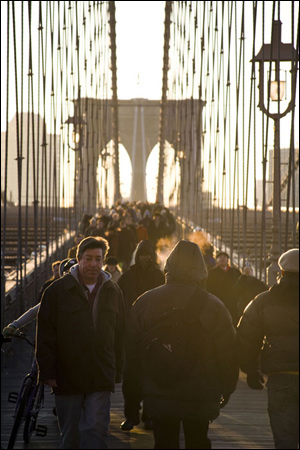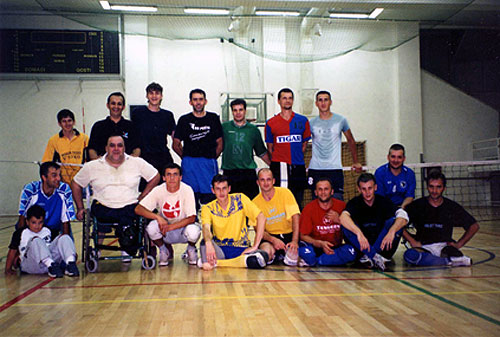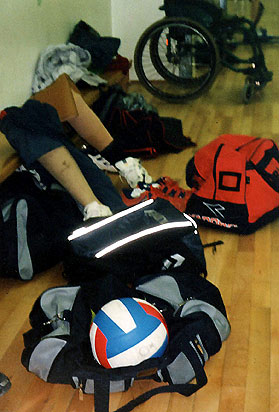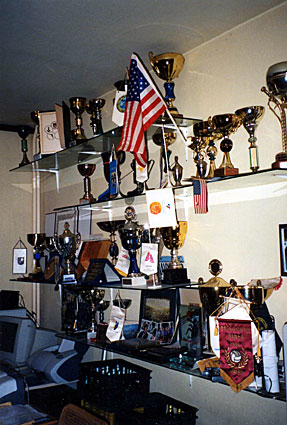The short angry gusts of wind that bend the branches of the palm trees and blow the miasma of the meandering sewage into the nostrils are a welcome — if feeble — respite from the debilitating heat of Port-au-Prince. Market women in old floral dresses shield themselves from the sun as they balance brimming baskets of produce. Men squat under the shade of trees, selling paintings, cell phone chargers, and tubes of car oil. Children hawk plastic pouches of water out of burlap sacks perched on their heads like oversized turbans, letting the cool contents slide over their brows and ears.
“Dlo, dlo, dlo, dlo, dlo,” shriek the young vendors as they try to lure thirsty pedestrians. When a customer comes they raise an arm, dive crooked fingers inside the sack, and pull a pouch out of the lot. A sachet of water costs 10 cents.
“Delmas, Delmas, Delmas, Delmas,” echoes another army of kids, urging pedestrians to board colorful tap-taps headed to an uphill neighborhood. A ride in one of those is an experiment in patience and humor, at twice the price of water.
It is the daily pulse of Haiti’s capital city. The patter of gunshots that sometimes rips the early evening haze and dies beneath the shouts of the kid-merchants does not seem to rattle anyone anymore. Homebound workers might quicken their step, honking drivers might lower their din, but panic is only a thought, not a reaction. Moments of public danger rarely stand apart from the normally frenzied pace of this town.
It has been a full year since the killings and kidnappings of civilians began, and the staggering number of the victims — more than 1,200 killed since last September and over 500 abducted since mid-February — seems to have dulled the survivors’ capacity for shock. In July, when violence peaked and at least six people were being plucked from the streets of Port-au-Prince each day, a couple of shots from a distance seemed more salute to the dead than threat to the living.
This is the kind of thing that battles common sense: in downtown Port-au-Prince the bustle of daily life lends an illusion of security — an illusion sustained by the cacophony and the ant-like collective movement on the streets. Police officers in black uniforms ride six deep in dusty pickups with the rear doors flung open, brazenly pointing the barrels of their automatic rifles against the river of cars. Blue-helmeted U.N. troops cruise along atop snow-white armored personnel carriers (APCs), the turret mounts swiveling about jammed intersections. The proximity of cops and soldiers diminishes the immediate danger, and so the illusion grows, despite the alarming statistics.
But the pushing crowds, panting traffic, car horns and compas rhythms rapidly thin out as one leaves the heart of the city, and the illusion vanishes too. On the potholed road to Toussaint L’Ouverture International Airport, and past its peeling marquis on to Bel Air, the air hangs empty and the haze thickens like a membrane of concentrated sunlight.

A tap-tap headed to an uphill neighborhood in Port-au-Prince. The cheerful colors of its facade and the contagious compas blaring from the car radio make up for a sweaty, bumpy ride in this distinctly Haitian public bus. (Gergana Koleva)
The situation
I arrived in Haiti last July to acquaint myself with a culture of dashing beauty, contagious vitality, unassuming playfulness — and joltingly stark contrasts. Although the purpose of my trip was journalistic, I had no badge, no press credentials, no letter of introduction from an important news organization. Instead, I arrived for my first dig into foreign freelancing with a modest research grant from my university in New York and a handful of local contacts given to me by a generous friend.
The check-in clerk at John F. Kennedy airport’s international departures surveyed my face, furrowed her brow, and questioned, “United Nations?” I shook my head. She studied my passport. While I waited for her to finish and tag my bags, I noticed that my line, for Flight 837 going to Port-au-Prince, was the thinnest of all surrounding Caribbean destinations.
“The situation,” as Haitians refer to the political impasse generated by the strain between the wealthy ruling elite and the masses of Haiti’s poor, had reached hysterical proportions.
Violence between chimères — the name of the mythical two-headed monster given militant supporters of former President Jean-Bertrand Aristide — and the equally militant members of the opposition has been escalating since February 2004, when Aristide left Haiti amidst a bloody popular rebellion. After his departure, hordes of admirers blocked city roads and highways with barricades of burning tires and protested the leader’s removal in chanting processions from their slum homes to the National Palace.
But if those were disparate attacks intended to inject terror during the spring and summer months, September saw the beginning of uninhibited street war. Prime Minister Gerard Latortue dubbed it “Operation Baghdad” after the rebels’ alleged use of Iraqi insurgent tactics in trying to pressure the U.S.-backed transitional government to restore Aristide. Slum residents viewed the police- and U.N.-orchestrated raids seeking to take out gang leaders in their neighborhoods as mass murder. Women, children, and elderly citizens living in proximity to alleged rebels’ homes were often killed in special operations. The chimères — who are said to be financed by the former president himself —responded by killing or kidnapping cops, civilians, and those they thought aligned with Latortue’s government and the foreign brain trust behind it. The violence claimed more than 1,000 lives and sent those who could afford it packing.
It broke off on September 30, 2004 — the 13th anniversary of the first coup d’etat against Aristide only seven months after he was inaugurated as the first democratically elected president of Haiti.

Abandoned cars and piles of trash litter the streets of Bel Air, a slum of Port-au-Prince where many militant supporters of former President Jean-Bertrand Aristide hail from. A decorative wire installation suspended between a lamppost and a house window reads “Titid,” an endearing appellation for the first democratically elected president of Haiti, who is said to have funded armed militants to protest his exile in South Africa. In the far background, the triumphant cupolas of the National Palace. (Gergana Koleva)
The priest
A young, charismatic Roman Catholic priest who spoke the language of the poor, Jean-Bertrand Aristide emerged from his pulpit in the slum of La Saline as a beloved leader of the masses during the long-overdue disintegration of the Duvalier dictatorship in the 1980s. In 1990, he won a landslide victory in unprecedented free elections, but his fiery rhetoric for empowerment of the poor did not sit well with the elite of wealthy mulattos, who to this day own most of Haiti’s natural and industrial resources. Neither did Aristide appeal to U.S. business and ideological interests in the region, or the Bush Sr. administration.
Thus in the fall of 1991, Haiti’s popular leader was overthrown. Re-installed three years later under Clinton’s presidency and with the help of 20,000 U.S. marines, and re-elected in a sham election in 2000 after sitting out a term, he was again forced to resign on February 29, 2004. But this time it was his own former partisans, backed by awakened voices from his own electorate, who insisted the humble priest had become a vicious dictator. There were marches, there were popular protests. Blood was spilt. Aristide quit.
Securing his safe exit to South Africa, where he is now in exile, the Bush administration — backed by the Canadian and French governments — asserted that Aristide stepped down voluntarily. Aristide said that American officials forced him to sign his resignation on the steps of his departing jet and “kidnapped democracy” as they shut the door behind him.

Solange holds a portrait of her son Enok, 34, who disappeared from their home in Bel Air on July 13 and whose body she found in a morgue the next day. She believes members of the Haitian National Police killed him when they invaded Bel Air searching for armed gangs. Slum residents and human rights activists have accused the police of raiding poor neighborhoods and summarily executing young men they regard as bandits. (Gergana Koleva)
Welcome to Bel Air
Bel Air’s name is a cruel joke. It hails from the colonial era when it used to be the capital’s fanciest neighborhood, and at the turn of the century its most prominent popular settlement for migrants from Haiti’s countryside. Today, tainted by a corrosive mix of human waste, rotting garbage, and burnt metal, life in this slum of Port-au-Prince is anything but fresh. Seared car skeletons line the streets. Heavy bolts lock the invisible denizens inside single-story cinderblock shacks. Palm trees poke defiantly among the tin roofs and tilted electric poles, but no friendly breeze stirs the broken spirit of the place. It is said that armed kidnappers guard its roads so as not to miss a good catch.
My translator Herby categorically refused to accompany me on this trip. My Haitian friend Garaudy who splits his time between New York and Port-au-Prince rolled his eyes and thought I should concentrate on interviewing local businessmen. My landlord Matt, a young American and former Peace Corps volunteer here, shot me a bemused look when I mentioned my plans. I won over one Haitian journalist, Reuters news service correspondent Guy Delva, but he said that we’d have to make it quick.
As we approached the house, the group of young men and women who sat on its tiny porch interrupted their talk. Some 15 pairs of eyes followed us from our car to the open door, jammed with more people, leaning, standing, and crouching at the threshold. Inside, Solange was serenely seated on the edge of the bed in a white eyelet dress and tattered flip-flops, dwarfed by a throng of neighbors around her, as if she had already been waiting for us. Her granddaughter, a solemn-faced three-year-old, sat in a chair next to her, eating a peanut butter sandwich and glancing at the floor.
Solange’s 34-year-old son, Enok, had vanished six days ago. She learned from a neighbor that police had arrested him. She didn’t know why, nor where they had taken him, so she went to inquire at the police precinct in Port-au-Prince. Nobody there knew anything about him either.
The Haitian National Police (PNH) have a bad reputation among many of Port-au-Prince’s poorest residents for the summary executions of civilians that unidentified police officers have carried out in recent months while trying to ferret out feared gang leaders. But the police are also the arch-nemesis of gangsters who see themselves as local heroes avenging the deaths of their fellow citizens.
“I knew there was one place left to look,” Solange continued. “I took my husband and we went to the morgue, and there we found him. He was killed. I know that police in black uniforms arrested him. I think the police killed him too. I don’t know who did, but he was in their hands.”
Solange doesn’t use words like “good” and “evil” when she talks about her son. She is sad and her eyes are empty, but dry. Look, look at his picture on the dining table, which has worn the same plastic tablecover for so long that the wooden corners are poking through. Its cheap metal frame is the only object in the house new enough to have a glint of luster. Other ornaments are an old mirror conquered by patina, a tattered map of Haiti, a couple of exposed sockets with dangling wires. Oh, but the walls — such bright blue fills the eye with the pristine brilliance of a postcard beach. No, he wasn’t formally employed, but he often found odd jobs at the port. He used to count the boats coming to dock at night. He was a quiet man. No, he never was involved with any of those gangs out there. Maybe he just happened to be on the street when the police came, looking for something. You see all these guys out there? They were all his friends. There’s a bunch of them who got arrested before him. It is a massacre. They bust into people’s houses and kill them.
The crowd that sat outside Solange’s door had been listening closely. They had been respectfully quiet, despite drawing more and more passers-by, until she and I breached the topic of the police. Now the narrow steps to the house are jammed with lean young men, some shirtless, some fingering their guns, and all with Aristide on their minds. As they hear us discuss the police, they begin elbowing each other for a better look.
“Look, journalist!” one of them yells as I strain to hear my friend’s translation of Solange’s words above the din on the street. I lift my eyes to see him drawing a black pistol out of the back pocket of his jeans. He points it up in the air to amuse me, to give me, the blan, as Haitians half-humorously, half-pejoratively call white foreigners, what he believes I have come to see. Or perhaps to convey his opinion of the police.

Enok’s daughter, 3, right, plays with friends in the back alley adjoining their house. Narrow, high-walled communal passageways weave between the houses in Port-au-Prince’s shantytowns, serving both as playgrounds for children and as ambush sites for kidnappers. (Gergana Koleva)
Bel Air, day two
July 20th — the day I was kidnapped — dawned as a typical day in Port-au-Prince, filled with stifling heat, shoving crowds, and ubiquitous transistors crackling with incessant news bulletins. It was the 10th day of my first foreign trip as a freelancer. Tomorrow, the streets would clog with people attending the public funeral of Jacques Roche, a journalist at the daily newspaper Le Matin who had been kidnapped and brutally murdered one week earlier after his family came $240,000 short of paying a $250,000 ransom. Many of his colleagues believe he was killed less for failing to pay up than for his adamant opinions against Aristide.
I’d never met Roche, but he had been my friend Dario’s high school teacher in Haiti almost 20 years ago. The two had remained close over the years and, following Dario’s suggestion, I emailed him last spring. He promised to help me once I got to Haiti. He was kidnapped on July 10th, the day I arrived.
The spate of kidnappings that erupted in Port-au-Prince last February have been attributed to political and criminal gangs with loyalties to Aristide and the lucrative side of a climate of insecurity. An Indian businessman and a Russian contractor were kidnapped in May, but were released after paying a ransom. A local doctor, a police officer, a Red Cross worker, and Jacques Roche were also kidnapped last summer, and killed.
Despite such alarming statistics, I had visited Bel Air to speak with Solange, and then, testing my luck, decided to go a second time into the neighborhood known to belong to the chimères. In Haiti’s 200-year history, the urban poor, whose interests these urban soldiers claim to defend, have never been regarded as worthwhile citizens by the country’s successive oligarchies, except for a few brief moments during Aristide’s presidency — first in 1991, then in 2000. Despite the fact that during his second term Aristide too had stripped the poor of the fragile hope for getting their voices heard in the hallways of the National Palace, many still regarded him as the humble Catholic priest who had fanned the flames that ended the Duvalier family dictatorship in 1986, and as their personal and only savior. I went to Bel Air in the hope of learning from those people why they still put their trust in him.
The whipping rain, huge potholes, and heaps of rotting garbage made navigating the narrow streets a daunting task for me and Guy, so at first I thought the young man who jumped in front of our blue Nissan Saloon needed help. That was before I saw his gun, ordering us wordlessly to pull up and step out.
My camera, tape recorder, cell phone, and sterling silver earrings quickly vanished in the pockets of the angry-faced men who stood us against a cement wall. My friend’s face glistened with sweat as he silently nodded to the gunman’s demand that he leave Bel Air immediately, and leave me there, the muzzle rammed into his temple. The rain beat down the rutted pavement, sweeping the streets clean of passersby. But it was only when a skinny youngster grabbed my wrist and pulled me inside an inner alley that I fully realized the danger. Prodding me onward, he brought me to an empty crumbling shack, where several others soon surrounded me, wrapping strands of my hair around their fingers and uttering obscene remarks.
As one of the men stared at me, I thought, desperately, to ask him about his name, using one of the few Kreyol phrases I knew. “Komoun ou rele?”
“Poshu,” he answered. He was a character out of a Miami gangster flick — muscular, barechested, with the smell of marijuana on his breath. “We’re Haitian mafia, baby,” he said in unaccented English. I wondered if he was one of those Haitian-American deportees angry at losing their place in the promised land, as some of Haiti’s criminals are said to have been. “It’s revolution,” he added.
“Revolution against whom?” I asked, but Poshu only repeated, “Revolution.”
My eyes traveled from one frowning man to the next. What to do about the one by the door, brandishing his rusty weapon and bearing down on me in silence?
I ventured a simple word. “Police?”
They all gathered around me. One took out a wallet and showed me a baby boy’s picture. I looked at Poshu for translation. “His son,” he said. “Dead.” The move was popular. The gunman at the door hid the weapon and came near me. He too took out his wallet, and there too was a baby’s photo.“Nephew. Dead. Don’t worry. No violence. Only money,” Poshu smiled at me, evidently amused by the mask of horror on my face. “Police mal. Anpil mal.”
If it hadn’t been tragic, my role as a POW against police brutality could have been comical. How could I, a Bulgarian national, be a meaningful pawn in the hands of a dozen desperate, disenfranchised Bel Air thugs? The Bulgarian embassy closest to the epicenter of this spectacle was in Cuba, and U.S. Embassy officials had told me before I arrived in Haiti that because I don’t hold an American passport, I was not to call on them in an emergency.
Ultimately, I was not as important to the chimères’ cause as Roche and the men who shared his fate. I am a woman, and so far no kidnapped woman has been killed — though a few have committed suicide after being viciously tortured. I was also fortunate to have been captured along with a veteran Haitian journalist, whose reputation went a long way with the urban gangsters he frequently writes about. They did not get the $100,000 they requested for my release, though they did get the contents of our wallets. The confluence of these circumstances allowed me to walk out of my three-hour confinement miraculously unharmed, but they also allowed me a profoundly intimate look at the possible effects of attempting to document the lives of people whose self-appointed guardians do not want to be documented.
Gergana Koleva
Dear Reader,
In The Fray is a nonprofit staffed by volunteers. If you liked this piece, could you
please donate $10? If you want to help, you can also:




















